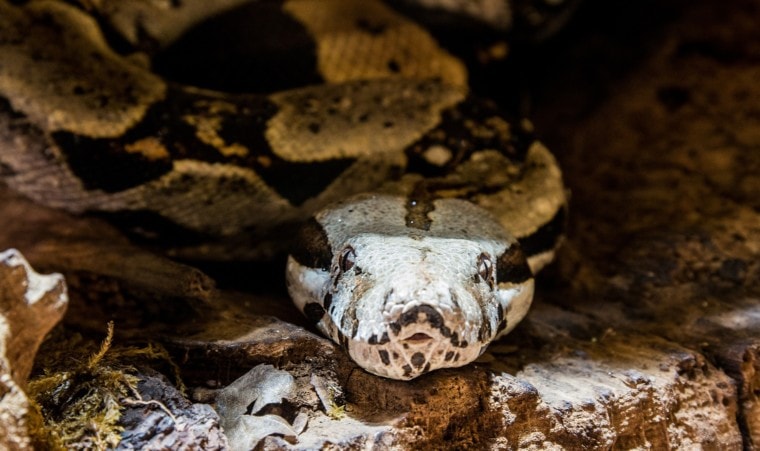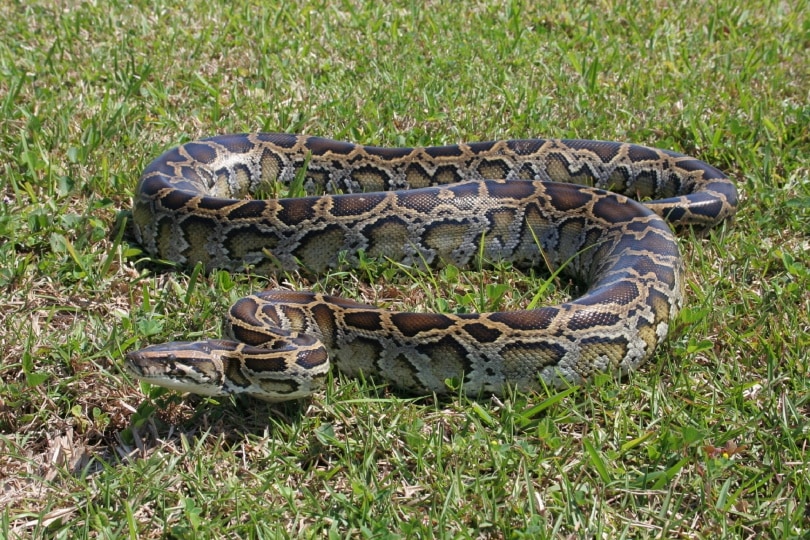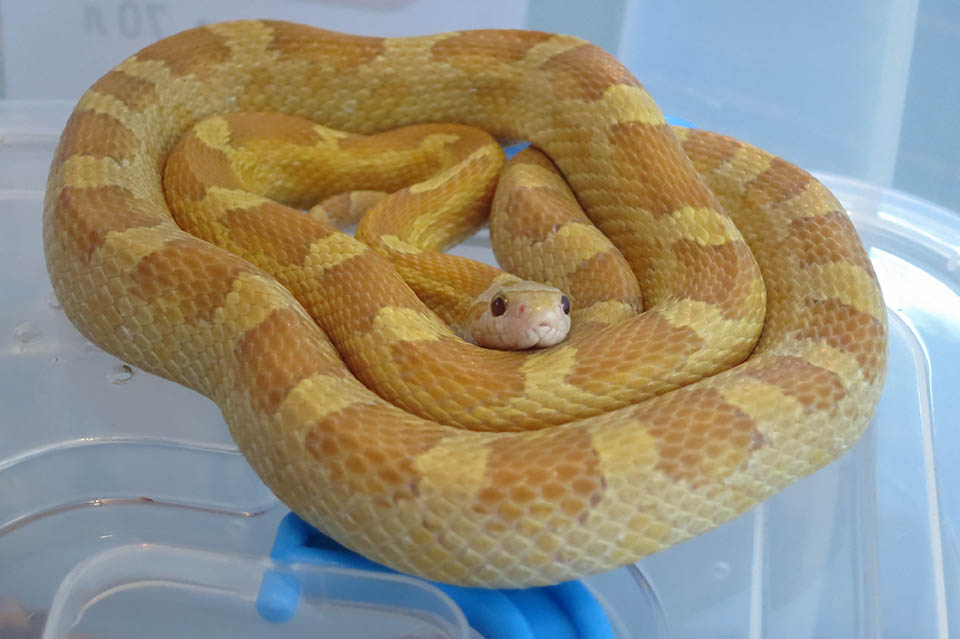
Native to tropical South America, anacondas, or water boas as they’re also called, are large, non-venomous snakes. Currently, there are four known species of anacondas, with the green anaconda being the most common.
The green anaconda is the world’s largest snake by weight and the second longest. Female green anacondas can grow up to 17 feet long, with males being relatively shorter. They typically weigh between 30 to 80 kg (66 to 176 pounds). Anecdotal claims of larger and heavier specimens do exist but are rarely definitively proven.
Anacondas usually reside near bodies of water – marshes, swampy areas, and along sluggish-moving streams and rivers. When they’re on solid ground, they’re slow-moving and clumsy but in the water they are deadly. An anaconda can suspend itself just under the surface of the water waiting for prey while hidden from sight. The color and patterns on their body provide the ideal camouflage. Under human care, anacondas eat animals they consider prey, such as fish, rabbits, chickens, or small pigs; in the wild, apart from mentioned, it can be even caimans, deer, or jaguars.
What Anacondas Eat in the Wild

In the wild, anacondas prey on many different animals including:
An anaconda can go long periods without eating especially after consuming a large meal. This snake kills prey by wrapping their thick muscular body around the prey and constricting until the animal suffocates. Many of the animals that this snake captures in the wild die from drowning as, at times, anacondas pull their prey underwater after they’ve grabbed onto them.
How a Wild Anaconda Hunts
Anacondas are fascinating creatures especially when they’re looking for something to eat. An anaconda feels a series of vibrations in the water when there is prey nearby. This big snake can also detect specific chemicals in the air with its forked tongue and Jacobson’s organ.
Additionally, an anaconda detects heat signatures given off by potential prey using the pit organs on the top of its upper lip. An anaconda does not see or smell well but that doesn’t stop this snake from being an avid hunter thanks to its other keen senses.
What Anacondas Eat as Pets

Please note that many states and jurisdictions may have legislation that prohibits owning, breeding, purchasing, or selling snakes or certain snake species. Always make sure you have permission to legally own an exotic pet before deciding to adopt one. If you are in the US, please refer to state laws before deciding to adopt an exotic pet. Elsewhere, please refer to the relevant laws where you reside.
Capturing wild animals to keep as pets is not advised, as this disrupts local ecosystems. Likewise, releasing exotic wild pets back to the wild is also not advised, as this too can disrupt the balance of local ecosystems.
Snakes are a long term commitment and are generally not considered safe around children. They are also not compatible with other pets, including cats, dogs, birds, rabbits, and other exotic pets. They are opportunistic hunters that may attempt to strike or constrict anything they perceive as a potential meal, including their handlers.
When kept as a pet, an anaconda must be provided with food that meets its nutritional requirements. It’s important to know that pet anacondas can refuse to eat all food except their favorite prey, so be ready for that if you keep one of these big snakes as a pet. Pet anacondas can be fed:
Another important thing to know about feeding a pet anaconda is that this snake cannot distinguish between food and their handler. When hungry, an anaconda will strike at anything that moves within their range, so great care must be taken when feeding an anaconda.
It’s Not Necessary to Feed a Pet Anaconda Live Prey
If you’re squeamish about the idea of feeding your pet anaconda live animals, don’t worry. An anaconda will eat a dead animal because it won’t usually turn down a free and easy meal. In fact, snake experts recommend that anaconda owners exclusively feed their anacondas pre-killed prey like frozen thawed mice and rats. This is recommended because a live animal like a rodent will fight for its life when grabbed by this big snake, which can result in an anaconda getting injured by the prey’s sharp teeth and claws.
Because anacondas prey on moving animals in the wild, feeding a pet anaconda requires a little trickery on your part. Simply use a pair of long-handled tongs or forceps to hold the prey by the tail and dangle it a few inches from the anaconda’s face. After exploring the prey with their tongue, the anaconda will grab the food and start constricting it. If your pet anaconda doesn’t take the prey, touch the prey to the snake’s nose to trigger their feeding response. If your snake refuses to eat for an unexplained reason, consult your veterinarian.
Because anacondas sold as pets are captive-bred, most will prefer eating pre-killed food because that’s the only food they have access to. Of course, you can feed a pet anaconda live prey if you’d like. However, the risk of injuries from prey usually isn’t worth it, as wounds a prey inflicts on the snake almost always require medical care from a veterinarian and can become worse if left unaddressed.
How Often Should You Feed Your Pet Anaconda?

A young pet anaconda should be fed small animals like mice and birds about once every 4 days. As they grow larger, they should get food like rats, small pigs, and rabbits about once every 7 to 10 days. You’ll know when your anaconda doesn’t need food when they refuse to eat their favorite prey.
As stated earlier, an anaconda may not distinguish between you and its prey so use caution when feeding your pet snake. Anacondas have four rows of backward-pointing teeth they use to grasp their prey and those teeth are sharp! And don’t forget that dead animals rot quickly so be sure to remove any uneaten prey from your snake’s enclosure.
See Also:
- Do Snakes Like Being Pet? Everything You Need To Know!
- Are Anacondas Poisonous? What You Need to Know
Conclusion
Anacondas are massive snakes that many people find fascinating. If you’re thinking of keeping an anaconda as a pet, it is best to learn all you can about these snakes before adopting one. This large snake needs an enclosure suitable to their size and must be fed a consistent, protein-rich diet to ensure they can live a long and healthy life.
Featured Image Credit: blende12, Pixabay











